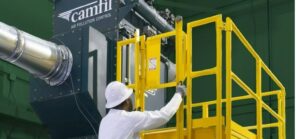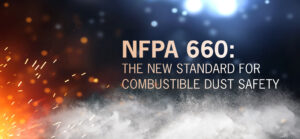When a metal fabrication company approached Camfil Air Pollution Control for a quote on a dust collection system to handle welding fumes, they provided their own set of specifications. However, Taylor Morgan, Camfil’s regional manager, recommended an on-site visit to evaluate the facility’s layout and processes to ensure a more tailored and effective dust collection system design.
Initially, the company declined, focused solely on fulfilling an RFQ process with another vendor in mind. However, after Morgan emphasized the value of a comprehensive site assessment and discussed alternative solutions, the company reconsidered and ultimately switched to Camfil. Unlike other vendors, Camfil took the time to prioritize what was truly best for them.
The company is now extremely satisfied with their dust collection system, confident that it provides the optimal design to safeguard employee health and safety.
Get the Details by Watching the Full Switching Video
Get the full story by watching this video.
The Dangers of Welding Fumes
Welding fumes generated during metal fabrication pose serious risks to worker health and the environment. These fumes consist of extremely fine metal particles and metal oxides, and harmful gases, categorizing them as fumes rather than simple dust.
Airborne welding fumes can form explosive dust clouds that can trigger flash fires or explosions when ignited, leading to property damage and loss of life. Health risks are also significant, as exposure to these fumes can irritate the nose, throat, and eyes. Long-term exposure may lead to severe complications like kidney failure, emphysema, and damage to the brain and nervous system.
Accumulated metal dust further impacts the workplace by interfering with sensitive electronic equipment, causing overheating or short-circuiting, which can lead to early component failure. Particle build-up on electrical power components can result in dangerous arc flashes, endangering both personnel and equipment.
Metals with Elevated Health Risks
Some metals used in welding pose particularly high risks. For example, welding stainless steel releases fumes containing chromium, nickel, and other alloys. Chromium exposure has been linked to various cancers, while nickel exposure can cause metal fume fever, a condition with flu-like symptoms such as chills, sweating and fever. Manganese, a primary metal in welding wire, is associated with manganism, a neurological disorder that mimics Parkinson's disease.
The Occupational Safety and Health Administration (OSHA) sets permissible exposure limits (PELs) for different metal dusts in welding fumes, based on an eight-hour time-weighted average. However, most welders are exposed to levels 25 to 1,000 times higher than set limits., highlighting the need for better fume control measures.
Dust Collectors Eliminate the Dangers
Proper fume extraction is crucial in welding operations to safeguard workers from harmful emissions. Standard methods like HVAC systems, open windows, and fans are generally inadequate for ventilating and preventing the spread of fine metal fumes throughout a facility.
The Occupational Safety and Health Administration (OSHA) advises using dust collection systems and filters to minimize the release of dust from process equipment. A dust and fume collection system with a high-efficiency filter cartridge can efficiently capture and eliminate welding fumes and other hazardous particles, either by recirculating clean air back into the workspace or venting it outside.
These dust collection systems come with self-cleaning mechanisms that pulse away debris from the filter cartridges, extending their life between replacements.
Types of Dust Collectors
Cartridge dust and fume collectors are typically categorized into three types:
Source Capture Systems
Ideal for smaller setups, these systems use a flexible capture arm or an enclosure around the workspace. The Zephyr III™ Portable Dust Collector, for instance, features a fume arm that captures welding fumes and other airborne contaminants at the source, making it perfect for periodic use across different locations.
Canopy Hoods
Canopy hoods attach directly to dust-producing process equipment to help capture fumes. Their efficiency can vary depending on workspace limitations, the type of equipment, and the quality of installation and configuration.
Ambient Systems
Ambient systems filter the air throughout a facility. They can be part of a central system or a network of smaller collectors, effectively servicing larger areas.
With its knowledge of NPFA standards, Camfil Air Pollution Control can guide you in mitigating combustible dust at your facility by specifying a compliant and effective dust collection system. Contact our dust collection experts to assess your needs and recommend the most effective dust collection system for your requirements.
 Camfil’s Gold Series X-Flo industrial dust collector is widely recognized as a best-in-class dust collection system for managing dust and fumes. Its modular design allows for customization to fit specific application needs while occupying minimal space.
Camfil’s Gold Series X-Flo industrial dust collector is widely recognized as a best-in-class dust collection system for managing dust and fumes. Its modular design allows for customization to fit specific application needs while occupying minimal space.
Each module houses four filter cartridges made from HemiPleat pleated filter media, providing greater surface area exposure to the airstream for improved dust capture. With filtration efficiencies up to MERV 15, HemiPleat filters enable facilities to meet or exceed OSHA indoor air quality standards for most metal dusts.
Effective fume control is crucial for a safe and healthy work environment, helping to minimize risks of both short- and long-term health issues. For many fabricators and manufacturers, clean air in the facility is essential, especially for those adhering to internal standards that go beyond OSHA’s PELs.
Camfil can assist in sizing the appropriate fume collector system tailored to your specific operations. Find out more about Camfil at Industrial Dust & Fume Collectors.
 Americas
Americas 




